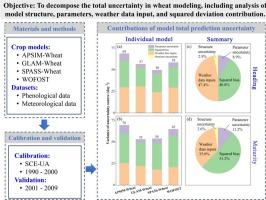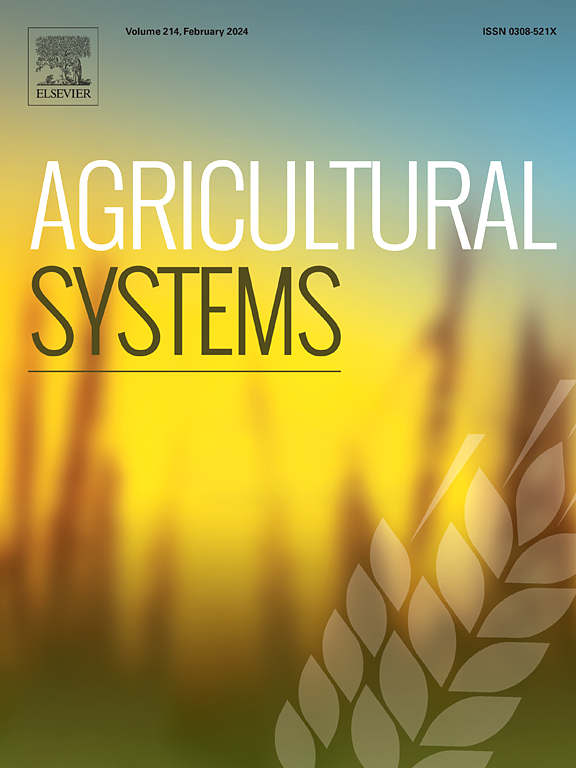Decomposing the total uncertainty in wheat modeling: an analysis of model structure, parameters, weather data inputs, and squared bias contributions
IF 6.1
1区 农林科学
Q1 AGRICULTURE, MULTIDISCIPLINARY
引用次数: 0
Abstract
CONTEXT
The comparison of agricultural models and the conduct of crop improvement research have garnered significant attention in recent times. One of the primary objectives in this field is to pinpoint and mitigate the uncertainties inherent in modeling the effects of climate on crop growth and productivity. Enhancing the precision and reliability of crop models has emerged as a critical concern.
OBJECTIVE
In this study, we calibrate and validate four wheat phenology models using wheat phenology data from 1990 to 2009. More importantly, we explain three significant sources of uncertainty in wheat phenology models, namely model structure, model parameters, and weather data inputs.
METHODS
This study examines four wheat models—the GLAM-Wheat model, APSIM-Wheat model, SPASS-Wheat model, and WOFOST model—to simulate phenological changes across 32 agricultural meteorological stations in the North China Plain. Additionally, the three main sources of uncertainty in the model are quantified using the Markov Chain Monte Carlo (MCMC) method.
RESULTS AND CONCLUSIONS
The results indicate that all four wheat phenological models effectively simulate the growth of wheat in the study area, with an average RMSE ranging from 4.4 to 5.2 days for the heading stage and from 4.7 to 5.6 days for the maturity stage. The uncertainty analysis encompasses parameters, squared bias, weather data inputs, and model structure. During the heading stage, the overall contributions of these uncertainties are 8.9 %, 40.8 %, 47.4 %, and 2.9 %, respectively. During the maturity stage, these contributions are 11.2 %, 51.2 %, 35.0 %, and 2.6 %, respectively. Weather data inputs are identified as the primary sources of uncertainty.
SIGNIFICANCE
This study quantifies the uncertainty within wheat phenology models, a critical step towards enhancing the precision and dependability of crop models. Such efforts hold substantial importance in shaping agricultural policies and refining management practices, ultimately aiding in tackling the challenges posed by impending climate change.

分解小麦模型中的总不确定性:模型结构、参数、天气数据输入和平方偏差贡献的分析
近年来,农业模式的比较和作物改良研究的进行引起了极大的关注。这一领域的主要目标之一是查明和减轻气候对作物生长和生产力影响建模中固有的不确定性。提高作物模型的精度和可靠性已成为一个关键问题。目的利用1990 - 2009年小麦物候数据,对4种小麦物候模型进行校正和验证。更重要的是,我们解释了小麦物候模型中三个重要的不确定性来源,即模型结构、模型参数和天气数据输入。方法采用gam - wheat模式、APSIM-Wheat模式、SPASS-Wheat模式和WOFOST模式,模拟华北平原32个农业气象站的物候变化。此外,利用马尔可夫链蒙特卡罗(MCMC)方法对模型中的三个主要不确定性源进行了量化。结果与结论4种小麦物候模型均能较好地模拟研究区小麦生长,抽穗期平均RMSE为4.4 ~ 5.2 d,成熟期平均RMSE为4.7 ~ 5.6 d。不确定性分析包括参数、平方偏差、天气数据输入和模型结构。在抽头阶段,这些不确定性的总体贡献分别为8.9%、40.8%、47.4%和2.9%。在成熟阶段,这些贡献分别为11.2%、51.2%、35.0%和2.6%。天气数据输入被认为是不确定性的主要来源。本研究量化了小麦物候模型中的不确定性,这是提高作物模型精度和可靠性的关键一步。这些努力在制定农业政策和完善管理实践方面具有重要意义,最终有助于应对即将到来的气候变化带来的挑战。
本文章由计算机程序翻译,如有差异,请以英文原文为准。
求助全文
约1分钟内获得全文
求助全文
来源期刊

Agricultural Systems
农林科学-农业综合
CiteScore
13.30
自引率
7.60%
发文量
174
审稿时长
30 days
期刊介绍:
Agricultural Systems is an international journal that deals with interactions - among the components of agricultural systems, among hierarchical levels of agricultural systems, between agricultural and other land use systems, and between agricultural systems and their natural, social and economic environments.
The scope includes the development and application of systems analysis methodologies in the following areas:
Systems approaches in the sustainable intensification of agriculture; pathways for sustainable intensification; crop-livestock integration; farm-level resource allocation; quantification of benefits and trade-offs at farm to landscape levels; integrative, participatory and dynamic modelling approaches for qualitative and quantitative assessments of agricultural systems and decision making;
The interactions between agricultural and non-agricultural landscapes; the multiple services of agricultural systems; food security and the environment;
Global change and adaptation science; transformational adaptations as driven by changes in climate, policy, values and attitudes influencing the design of farming systems;
Development and application of farming systems design tools and methods for impact, scenario and case study analysis; managing the complexities of dynamic agricultural systems; innovation systems and multi stakeholder arrangements that support or promote change and (or) inform policy decisions.
 求助内容:
求助内容: 应助结果提醒方式:
应助结果提醒方式:


